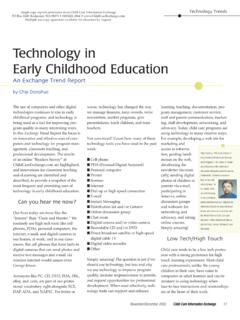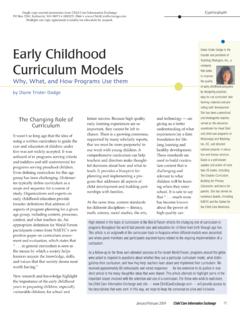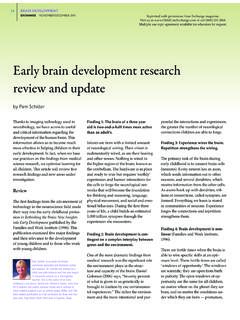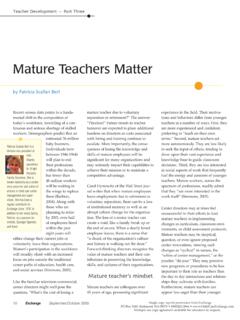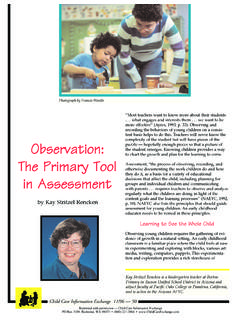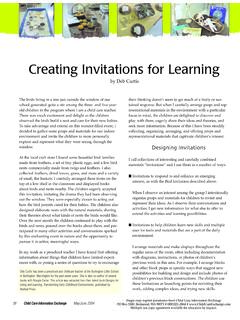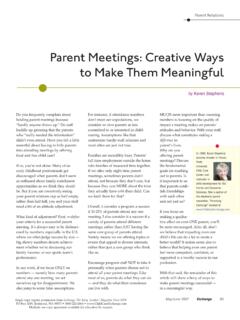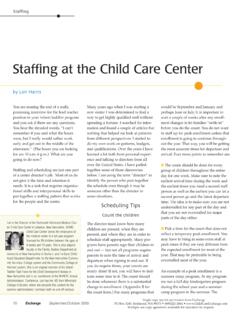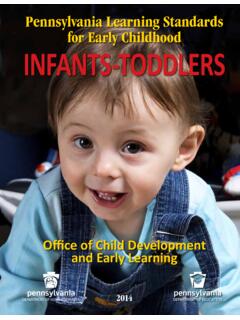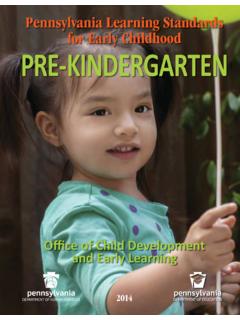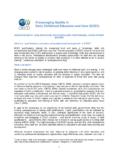Transcription of What Assessment Means to Early Childhood Educators
1 72 ExchangeSeptember/October 2004 Assessmentcific nature of the problem. For example, ascreening tool such as theAges and StagesQuestionnaires (Bricker & Squires, 1999)would be administered to determinewhether there is cause for concern aboutSean s language development. If resultsfrom the screening show a delay, an in-depth Assessment is conducted to deter-mine the specific type of delay, thestrengths and needs of children, and rec-ommendations for intervention. Assessments can also be used to identifyappropriate curricula and teaching strate-gies for individual children and to docu-ment children s progress over time. Forexample, teachers can develop a system-atic plan to document Sakara s progressin attending to a task and to identifywhich teaching strategies help her.
2 Thistype of Assessment is referred to as pro-gram Assessment . Program assessmenttools can also be used for program evalua-tionpurposes when comparing the perfor-mance of groups of children before andafter instruction. For example, teacherscan gather data on children s languageand literacy behaviors at the start of theschool year, before they begin daily pic-ture book reading, and then again at theend of the year. Traditional and alternativeassessments A variety of methods and instrumentsranging from formal to informal observa-What Assessment Means toEarly Childhood Educatorsby Angela Notari Syverson and Angela LosardoTwo-year-old Seandoesn t talk aswell as other chil-dren of his sameage. He communi-cates using ges-tures and a fewone-word phrases,and his articula-tion is difficult tounderstand.
3 Is hislanguage delayed?Does he need spe-cial services?Four-year-oldSakara has diffi-culty payingattention andcompleting a can teachersdo to help her staymore focused?Teachers in thetoddler andpreschool rooms ofa child care centerrecently intro-duced a 15-minute picturebook reading timeinto the dailyschedule. Will theincreased picturebook reading timehave an impact onthe children s language and literacy develop-ment?These are questions Educators mighthave about the children and families intheir programs and about curricula andinstructional strategies they use in theirclassrooms. Observing children andreflecting on educational practices areintegral to high-quality care and educa-tion programs. A sound assessmentsystem can be a useful tool for guidingearly Childhood professionals in thisprocess.
4 What is Assessment andwhy is it important? Assessment can be defined as theprocess of gathering ongoing and com-prehensive information about specificaspects of a child s knowledge, behav-ior, skill level, or personality for the pur-pose of making evaluative decisions(Meisels, 2001). Assessments can be con-ducted for different purposes. Screeningand diagnostic tools were developed tomake identification and placement deci-sions for individual children. Screeningis a brief procedure that determineswhether a child s performance is suffi-ciently different from the performanceof other children of the same chronolog-ical age to warrant more comprehensivetesting. If there is suspicion of a delay,then a diagnostic assessmentprovidesmore in-depth information on the spe-Angela Notari-Syverson is SeniorResearcher at the WashingtonResearch Institute inSeattle where shedirects research,model develop-ment, and staffdevelopment projects in the area ofearly literacy and language assess-ment and intervention.
5 She hasauthored books and journalpublications in these areas and isco-author of Ladders to Literacy, anearly literacy curriculum developedfor use in inclusive education set-tings. Her educational backgroundalso includes degrees in childpsychology and communicationdisorders from the University ofGeneva, Switzerland. Angela Losardo is a professor atAppalachian State University inBoone, NorthCarolina. She hasalmost 30 years ofexperience in lan-guage and literacydisorders and and special Losardo has considerable experi-ence coordinating and conductingresearch projects, personnel prepara-tion programs, and other grant-related projects. She has publishednumerous journal articles, bookchapters, and instructional materialsfor practitioners in the areas of alter-native and cross-cultural assess-ment, Early language and literacy,and personnel preparation ininclusive Early Childhood has co-authored a book onalternative Assessment approacheswith Dr.
6 Angela Single copy reprint permission from ExchangePO Box 3249, Redmond, WA 98073 (800)221-2864 use copy agreement available for Educators by 2004 Exchange73 Assessmenttions are available for professionals touse when assessing children. Assess-ment tools can be grouped into twobroad categories: traditional and alterna-tive approaches toassessment usually involve use of stan-dardized tests for screening and diag-nostic purposes. Standardized tests arenorm-referenced, meaning that a child sperformance is compared to that of anormative group of children of the sameage, gender, geographic location, incomelevel, disability and/or cultural back-ground. Because items on standardizedtests are chosen for their capacity to dis-criminate between groups of children ofdifferent ages, the behaviors tested maynot necessarily be educationally rele-vant.
7 For example, items from standard-ized tests may include asking the childto remove a large round peg from formboard or to point to a pellet in a tests do not yield directinformation for making program deci-sions or choosing curricular content, nordo they provide insight into environ-mental factors and instructional strate-gies that may promote or hinder achild s progress. The results of this typeof test are generally presented as devel-opmental ages, IQs, or percentile approaches to assessmentpro-vide information about what childrenknow and can do rather than on howthey compare to other children. Alterna-tive assessments are the tools of choicefor Educators , because they can be usedto observe children s behaviors in every-day life and classroom activities androutines, as opposed to the highly struc-tured and contrived testing situationtypical of standardized tests.
8 Alternativeapproaches to Assessment take intoaccount the complexity and holisticnature of child development and focuson the interrelationships among devel-opmental domains of behavior. Forexample, a motor impairment in ayoung child may lead to a problem inoral language development, and a prob-lem in oral language development mayput a child at risk for later problemswith literacy. Acomprehensive and holistic view ofchildren can only be obtained if care-givers and teachers collaborate andshare information on an ongoing and Notari-Syverson (2001)describe three approaches to alternativeassessment that a) can easily be inte-grated into and across everyday activi-ties, b) draw from observations andinteractions with children and familiesinvolved in actual tasks and activities,and c) seek to measure children s learn-ing potential by measuring changes inperformance following mediation by models of Assessment includethose in which opportunities to observechildren s behavior are embeddedwithin the natural context.
9 Children areprovided with multiple opportunities toperform skills across domains of devel-opment with different people, usingdifferent materials, in multiple opportunities for childrento perform skills in everyday activitiesis facilitated by use of curriculum-basedassessments. Curriculum-based assess-ments (CBAs) are developmental check-lists or simple tasks used to measure achild s progressive mastery of a curricu-lum. Assessment items are usuallyordered from simple to more complexand organized by developmentaldomains ( , problem-solving, commu-nication, physical, and socio-emotionaldevelopment). Two examples of CBAare theAssessment, Evaluation, and Pro-gramming System (AEPS) for Infants andYoung Children (Bricker, 2002) and theCarolina Curriculum (Johnson-Martin,Attermeier, Hacker, 2004).
10 Performance Assessment and Assessment is abroad term that refers to tasks that givechildren the opportunity to demonstrateand apply their knowledge. Talkingabout pictures in a book, riding a tri-cycle, asking an adult to get a favoritetoy out of the child s reach are examplesof performance tasks where children candemonstrate a variety of language, liter-acy, cognitive, social, and motor completed in real-life contexts( , recognizing one s name on a cubbyhole or climbing playground equip-ment) are referred to as authenticassessment. Portfolio Assessment is a type of perfor-mance Assessment that refers to the pur-poseful collection of a child s workdocumenting the child s effort, progress,or achievement over time. For youngchildren, portfolios may include perfor-mance-based samples such as art anddrawings, photographs of block con-structions, videotapes, developmentalchecklists, anecdotal notes of teacherobservations, and interviews with par-ents.
